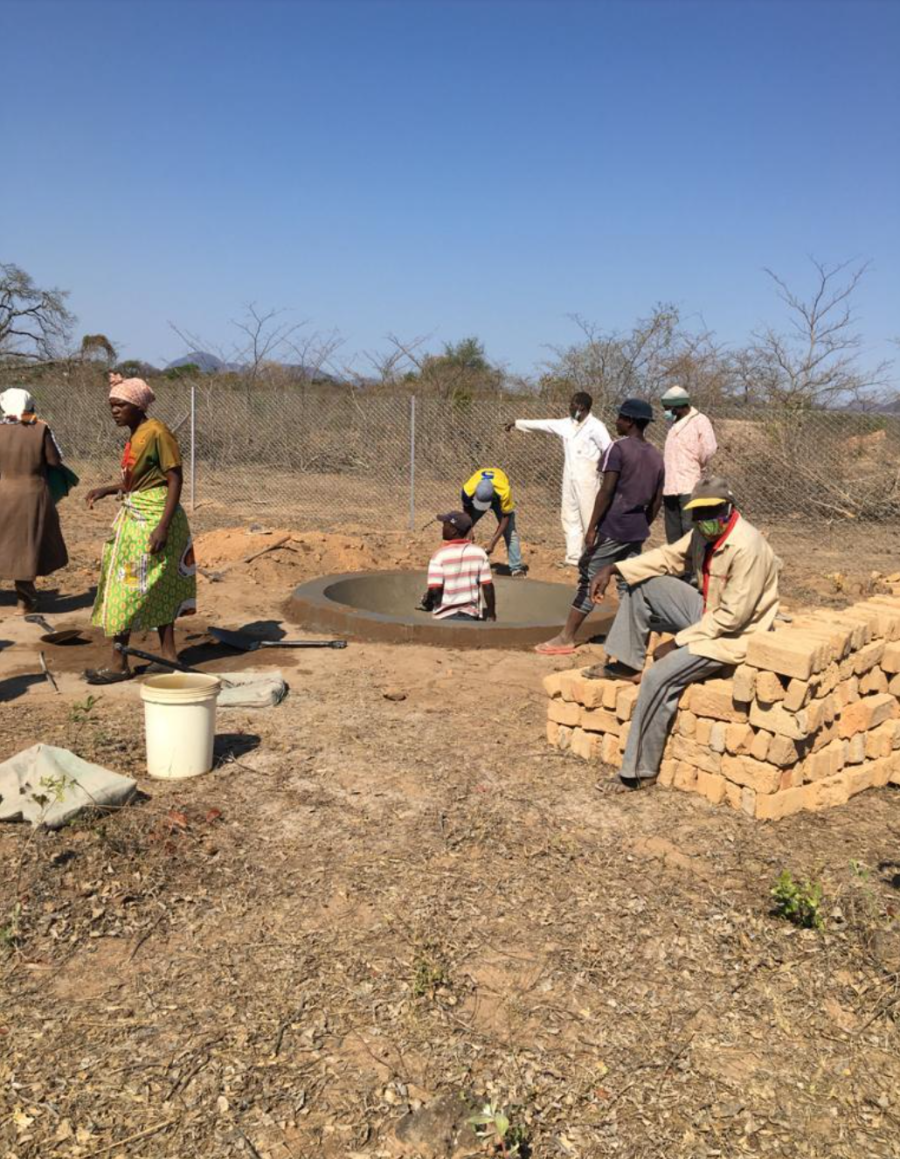Somewhere in Zimbabwe's northern Zambezi Valley, a local farmer is wielding torches defending his only source of livelihood from a herd of hungry elephants. It is likely that these pachyderms will win the contest, unless the farmer resorts to the use of his rifle. Luckily, the farmer's neighbors join his efforts and together they effectively scare the herd back into the bush. Both elephants and villagers are safe on this night, but what about tomorrow?
The wildlife of Eastern and Southern Africa are vital to the function of regional ecosystems and they generate substantial economic benefits, a point underscored by tourism providing Zimbabwe's third largest source of revenue. Yet the legacy of colonialism perpetuates a system of social and economic disparities between those enjoying the recreational and financial benefits of wildlife, and those bearing the costs of living with it. These disparities are starkly revealed at the edges of national parks, where all too often wildlife and the rural poor compete for scarce land. Increasingly human and wildlife conflict meets with tragic results: people risk their lives defending property from marauding wildlife, while wildlife are being eliminated at an alarming rate. The case of Zimbabwe offers an in-depth look at this problem, and a novel approach toward mitigating human-wildlife conflict known as the Communal Lands Management Programme for Indigenous Resources (CAMPFIRE).
A Step Back in Time
People and wildlife have long coexisted in Zimbabwe, according to historian David Beach. Prior to colonization, Shona and Ndebele people primarily engaged in agro-pastoral and hunting activities for subsistence. Local people relied on wildlife for protein, skins and other animal products, and the benefits of hunting offset the dangers of living with wildlife.
Land and wildlife utilization in pre-colonial Zimbabwe were shaped by ethno-ecological knowledge based on the region's micro-environments. As in other indigenous societies, social conformity and religious sanctions fostered compliance to this regime, where the founding ancestral spirits were regarded as the owners of wildlife. Through the channeling of spirit mediums, local people believed their ancestors set forth regulations governing the use of natural resources, and transgression of ancestral codes of behavior would surely result in the withdrawal of the bounty of the land and its resources. In this sense, coexistence between humans and wildlife populations relied upon informal institutions predicated upon the social values placed on wildlife.
Colonialism, Expropriation, and Disempowerment
With the onset of indirect colonial rule in 1890, the British seized Zimbabwe's most productive farmlands for large-scale commercial agriculture, resettling indigenous farmers onto the country's least fertile and most fragile lands, presently known as the communal lands. By the time of independence in 1980, more than sixty percent of Zimbabwe's total population occupied these communal lands. Exacerbating this dilemma was the rapid conversion of wildlife habitat to farmland, effectively pushing the last remaining wildlife populations onto the communal lands as well. The demands of both humans and wildlife for natural resources in these ecologically marginal lands paved the way for bloody conflict.
Simultaneously, the human-wildlife relationship was further eroded as proprietorship of wildlife was expropriated to the colonial government. Hence, tenure security was lost and local communities no longer had a vested interest in maintaining the wildlife once considered "their animals". Naughton (1998) claims that as property of the state, wildlife came to be viewed as "government's cattle" to be tolerated with resignation or poached, ultimately devaluing the entire wildlife resource base.
Decentralizing Wildlife Management and CAMPFIRE for All
Since independence in 1980, the Mugabe government has made little effort to mitigate resource conflict in the communal lands. With national parks receiving an ever-diminishing stipend from the national treasury, they fail to address wildlife behavior outside park boundaries where the majority of human/wildlife conflict occurs. According to World Wildlife Fund resource ecologist Richard Taylor, between 1989-1991 some 1,000 problem animal reports were filed in a single district, with 70% of those incidents being elephant related. Rural resident have no legal recourse other than to report their losses to an ineffectual park service. These numbers ultimately translate into tremendous local resentment toward wildlife, often in the form of poaching.
Given these circumstances, many African conservationists argued that wildlife survival depends on local people regaining ownership of wildlife, allowing them to benefit directly from its conservation. Yet devolving natural resource management to local communities is a complex matter, requiring well-established institutional structures and tenure systems capable of facilitating effective management, particularly for a fugitive resource such as wildlife. Critics cautioned that because most local institutions governing natural resource use in the communal lands were dismantled during ninety years of colonial rule, new institutions would need to be created. Hence, CAMPFIRE emerged in 1989 from Zimbabwe's Department of National Parks and Wildlife Management (DNPWLM) as a means of facilitating the devolution of natural resource management while building local institutions. In conjunction with the World Wildlife Fund for Nature, the University of Zimbabwe's Centre for Applied Social Sciences, Africa Resources Trust and Zimbabwe Trust, the DNPWLM has assembled a multidisciplinary suite of actors to assist in the creation and implementation of the CAMPFIRE program by providing expertise in such areas as institution building, ecological monitoring and economic research. These efforts contribute to the long-term viability of community-based conservation and development.
Reinventing Community Institutions
CAMPFIRE's core tenet maintains that those bearing the costs of living with wildlife should also benefit, monetarily or otherwise, from the utilization of those resources. Implementation of CAMPFIRE requires that rural communities obtain approval from the DNPWLM for a wildlife management plan. Once approved, rural communities have rights to access wildlife, enabling them to satisfy many of their material needs in a sustainable manner. By engaging in activities such as safari hunting and nature tourism, CAMPFIRE projects earned US$1,384,083 (Z$20 million) in 1997, according to the NGO Zimbabwe Trust. For the rural residents, tangible benefits include well drilling to provide clean drinking water; construction of schools and health clinics; fencing arable and residential land and the funding for fence maintenance; road development and installation of grinding mills. Currently, 26 districts throughout Zimbabwe are sustainably managing their wildlife resources and shaping their own rural development through CAMPFIRE, including every district bordering a national park. This is significant because CAMPFIRE is reshaping local people's perception of wildlife as a valuable resource rather than a worthless nuisance, and conservation efforts are less likely to be viewed in terms of the cultural imperialism long associated with national parks.
However, the growing popularity of CAMPFIRE raises critical questions concerning access rights. With a steady influx of immigrants intensifying rural land use, it is in the interest of communal lands residents to control access to their ward if wildlife utilization is to be legitimized. Yet establishing rules about access to communal land does not necessarily mean effective enforcement at the community level, and the inability of local communities to exclude new settlers poses a serious threat to achieving sustainable resource use and maintenance of wildlife diversity. As Elinore Ostrom's research reveals, if rural communities cannot enforce exclusivity on their resource base under serious `free-riding' pressures, community-based conservation approaches are doomed.
Additionally, issues of community membership and resource access rights provide a setting for conflict between traditional authorities and the statutory-based, locally elected council committees. Specifically, the de facto allocation and management of lands and revenues by local chiefs and headmen often undermines the resource management objectives of council committees, to whom authority is devolved under CAMPFIRE. In turn, council committees have regularly failed to return significant wildlife-generated revenues to local communities, fueling local resentment toward any form of regulation. Moreover, internal divisions within communities often inhibits full participation in much of the decision-making that CAMPFIRE requires of participant communities. Given these conditions, the inevitable role of government as ultimate enforcer suggests that total devolution of natural resource management is an unrealistic goal. It may be that despite a policy aimed at achieving community-based conservation, the realistic solution will require a co-management arrangement between local communities and the DNPWLM, at least in the short-run until use rights are more stable.
Despite these institutional concerns, CAMPFIRE is proving itself to be a viable and popular landuse option for Zimbabwe's rural communities. Overall elephant poaching has declined, and CAMPFIRE communities are becoming more tolerant of elephant incursions on their land. According to the CAMPFIRE Association, the number of elephants killed for damaging crops in Gokwe District, for example, dropped from 45 to 3 within three years of CAMPFIRE operations. In Mahenye District, villagers set aside agricultural land for elephant reserves, and in Gaza-Komanani, villagers have dug water holes and arranged food deliveries for their elephants in times of drought. With assistance from government and international NGOs, Zimbabwe's rural communities are implementing basic conservation and management techniques such as counting game, setting hunting quotas and providing game scouts to monitor wildlife and deter poaching. As an alternative to more traditional centrist development models, CAMPFIRE's holistic approach incorporates the dynamics of local land-use systems while attempting to give local people a legitimate voice in the use of their wildlife. Moreover, CAMPFIRE offers great potential for reconciling the interests of rural communities and the conservation of wildlife.
References
Beach, David. 1984. Zimbabwe Before 1900. Harare: Mambo Press.
Child, Brian and J.H. Peterson, Jr. 1991. CAMPFIRE in Rural Development: the Beitbridge Experience. Joint Working Paper 1/91. Harare: Branch of Terrestrial Ecology, Department of National Parks and Wildlife Management and Centre for Applied Social Sciences, University of Zimbabwe Publications Office.
Murphree, Marshall. 1991. Communities as Institutions for Resource Management. Center for Applied Social Sciences, University of Zimbabwe Publications Office.
Naughton- Treves, L.. In press. "Whose Animals?, A history of property rights to wildlife in Toro, western Uganda", Land Degradation and Development. Special issue on environmental history. A. Bebbington and S. Batterbury, (eds.)
Ostrom, Elinore. 1990. Governing the Commons: The Evolution of Institutions for Collective Action. Cambridge: Cambridge University Press
Taylor, R.D. 1993. Elephant Management in Nyaminyami District, Zimbabwe: Turning a Liability into an Asset. WWF Multispecies Animal Production Systems Project. Harare: Zimbabwe.
Zimbabwe Trust, 1990. People, Wildlife and Natural Resources: the CAMPFIRE Approach to Rural Development in Zimbabwe. Zimbabwe Trust; Harare, Zimbabwe.
Article copyright Cultural Survival, Inc.


